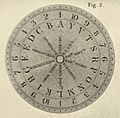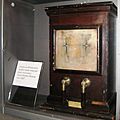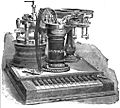Electrical telegraph facts for kids
The electrical telegraph was an amazing invention that used electric signals to send messages over long distances. Before it, people had to send messages by hand, like with letters or messengers, which took a long time.
With the electrical telegraph, an operator would press a special key, like a switch. This would send electric signals through wires. At the other end, another operator would hear beeps or see movements. They would then write down the message. It was a super fast way to communicate for its time!
Contents
Early Electrical Telegraphs
Many clever people worked on making the electrical telegraph a reality. Here are some of the first versions:
Gauss and Weber's Telegraph
In 1833, two scientists named Carl Friedrich Gauss and Wilhelm Weber set up a telegraph line. It was about 1,000 meters (or 1 kilometer) long and stretched over the rooftops of a town. This was a very early experiment showing how electricity could send messages.
Carl Steinheil's Network
Following their work, Carl August Steinheil built a small telegraph network between 1835 and 1836. He even put a telegraph line next to the first German railroad in 1835. This showed how useful telegraphs could be for things like train schedules.
Schilling's Telegraph
Another early telegraph was made by Pavel Schilling. His machine had a keyboard with 16 black and white keys. These keys were used to turn the electric current on and off, sending different signals.
David Alter's Invention
Dr. David Alter also created an electrical telegraph. He showed it to the public in 1837. This was one year before the famous Morse telegraph became well-known.
Morse Telegraphs
In the United States, the electrical telegraph became very popular thanks to Samuel Morse and his assistant, Alfred Vail. Morse built his first electrical telegraph in 1837. It was special because it could send messages over very long distances, even with simple wires.
Alfred Vail helped Morse create the famous Morse code. This code used a series of short and long signals (dots and dashes) to represent letters and numbers. This made sending messages much easier and faster.
Related pages
Images for kids
-
Cooke and Wheatstone's five-needle telegraph from 1837
-
Hughes telegraph, an early (1855) teleprinter built by Siemens and Halske
-
Revolving alphanumeric dial created by Francis Ronalds as part of his electric telegraph (1816)
-
Pavel Schilling, an early pioneer of electrical telegraphy
-
German Lorenz SZ42 teleprinter attachment (left) and Lorenz military teleprinter (right) at The National Museum of Computing on Bletchley Park, England




















